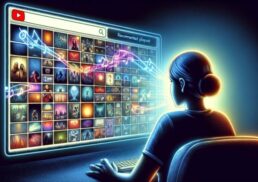Imagine playing your favorite video game with the most realistic lighting, shadows, and reflections, so lifelike that you feel completely immersed in the virtual world. This level of realism is now possible with raytracing, a rendering technique that simulates light paths and interactions with virtual objects. In this comprehensive guide, you’ll discover the science behind raytracing, its applications in gaming, comparisons with rasterization, performance implications, and future developments that will redefine the way we experience digital visuals.
Table of Contents
Key Takeaways
Ray tracing is an advanced technique for simulating light behavior and interactions with virtual objects.
Raytracing technology has revolutionized the gaming industry by providing lifelike visuals, improved rendering of shadows, reflections and transparency.
Advances in hardware, software and techniques are increasing the quality & realism of digital visuals across various applications such as gaming, VR & AR.
The Science Behind Raytracing

Ray tracing is magical in its accuracy, simulating the behavior of light and its interactions with virtual objects to yield realistic ray traced shadows, reflections, and translucence. It traces the paths of light rays bouncing off surfaces and calculates their interactions with objects, resulting in stunning, lifelike scenes. While traditional rendering techniques struggle to capture the nuances of light behavior, ray tracing gems like these have the potential to revolutionize computer graphics and gaming by providing more accurate and realistic visuals.
Yet, the practical implementation of ray tracing in computer graphics and games presents a challenge because it demands significant computational power to simulate and track each light ray emitted from a light source. To overcome this limitation, researchers and developers have created advanced light transport algorithms, such as the Whitted ray-tracing algorithm, which takes into account reflection rays and refraction rays to compute realistic lighting effects.
Cutting-edge technologies like DXR and specialized hardware components like RT cores have also been developed to accelerate ray tracing calculations and make it more accessible for a wider range of applications.
Light Rays and Interactions
In the context of ray tracing, light rays symbolize the light path as it bounces off surfaces. Each ray undergoes interactions such as reflection, refraction, and absorption. These interactions are governed by well-established optical laws, with the reflection direction dependent on the surface orientation and the incoming light direction, while Snell’s law can be employed to calculate the refraction direction based on the surface orientation, incoming light direction, and material refractive index.
Reflection and refraction of light rays occur when they travel through transparent surfaces or bounce off a shiny object’s surface. Such phenomena are due to the refraction of light. Advanced light-transport algorithms based on ray tracing, such as path-tracing, bidirectional path-tracing, and Metropolis light transport algorithms, have been developed to further enhance the accuracy and realism of light interactions in virtual environments, including ray traced reflections.
Ray Tracing Algorithm
The essence of ray tracing is encapsulated in its algorithm, which projects rays from the camera, identifies intersections with objects, and computes the light’s color and intensity at each intersection point. The Whitted Ray-Tracing algorithm, a classical example of light transport algorithms, utilizes the laws of reflection and refraction, the Fresnel equation, and the Phong illumination model to compute reflections, refractions, and the color of diffuse and glossy objects.
Upon intersecting a surface, a ray generates additional rays directed towards reflection, refraction, and the light source. Subsequent iterations of the intersection process are performed until no new rays intersect any objects. By tracing these rays and calculating their interactions with objects, the ray tracing algorithm creates a visually stunning and lifelike representation of a scene that accurately simulates the behavior of light and its interactions with virtual objects.
Learn more, visit Implementing the Raytracing Algorithm.
Real-Time Raytracing in Gaming
Thanks to advancements in hardware and software, real-time ray tracing in gaming has become readily available, facilitating realistic lighting and shadow effects in games. This technique enhances the visual quality and immersion of video games by simulating the behavior of light, providing more accurate and lifelike visuals, and improving the rendering of shadows, reflections, and transparency. As a result, real-time ray tracing has the potential to revolutionize the gaming industry and redefine the way we experience digital visuals.
A growing number of games now support ray tracing, which has a significant impact on gaming performance. However, to mitigate this performance impact, technologies like DLSS and FSR have been developed to upscale lower-resolution images, improving performance while maintaining visual quality. These advancements have made real-time ray tracing in gaming more feasible and accessible, allowing gamers to enjoy more realistic and immersive experiences.
Ray Tracing Games
Video games are increasingly adopting ray tracing technology, as exemplified by titles such as Minecraft, Battlefield V, Metro Exodus, and Aron’s Adventure, which demonstrate the potential of ray-traced graphics. By incorporating ray tracing technology, these games are able to deliver more realistic graphics, improved visual quality, and immersive gameplay experiences, captivating players with lifelike visuals and enhanced lighting effects.
As more game developers and content creators embrace ray tracing, we can expect to see an increasing number of games that support this technology in the future. Some upcoming games that will incorporate ray tracing to enhance their visual fidelity and provide players with more immersive and visually impressive game worlds include:
Redfall
Returnal
Sackboy: A Big Adventure
Forza Horizon 5
Dakar Desert Rally
Marvel’s Midnight Suns
Marvel’s Spider-Man: Miles Morales
Hardware Accelerated Ray Tracing
Modern graphics cards, such as Nvidia’s GeForce RTX series and AMD’s Radeon RX 6000 series, now support hardware-accelerated ray tracing, making it possible to achieve real-time performance in ray-traced games. These graphics cards are equipped with specialized hardware components, such as RT cores or dedicated ray tracing hardware, that are designed to efficiently process the complex calculations required for ray tracing, allowing for faster and more efficient rendering.
As ray tracing technology continues to advance, we can expect future generations of graphics cards to further improve ray tracing performance and efficiency. The next generation of Nvidia graphics cards, for example, is expected to feature real-time full ray tracing in 4K resolution at 60 frames per second, as well as new-gen Tensor Cores and RT cores for enhanced ray tracing capabilities. These advancements will make ray tracing more accessible to a wider range of users, enabling more realistic and immersive gaming experiences.
Raytracing vs Rasterization
Raytracing and rasterization are two separate rendering techniques, each with its own set of unique advantages and disadvantages. While raytracing provides more realistic lighting effects by simulating the behavior of light and its interactions with virtual objects, rasterization is faster and more efficient, making it the dominant rendering technique in real-time applications like gaming.
However, hybrid rendering techniques have emerged that combine the strengths of both raytracing and rasterization, providing a balance between visual quality and performance in real-time applications. Path tracing, a more advanced form of raytracing, simulates light transport more accurately but is computationally intensive, making it less suitable for real-time applications. In this context, “Ray Tracing Gems II” offers valuable insights into hybrid rendering techniques.
On the other hand, rasterization projects 3D vertices of triangles onto the screen using perspective projection, calculating the color and attributes of each pixel within the projected triangle. By combining raytracing and rasterization in hybrid rendering, it is possible to achieve real-time performance while maintaining high visual quality, paving the way for more realistic and immersive gaming experiences.
Path Tracing
Path tracing, a more advanced variant of raytracing, accurately simulates light transport by constructing paths from light sources that bounce around the scene until they either meet the camera or are terminated. Through tracing these paths, path tracing calculates the reflected radiance at each point on the surface, taking into account the incoming radiance from the surrounding environment. This process enables the precise simulation of global illumination and realistic lighting effects in rendered images.
While path tracing offers more accurate and realistic lighting effects than traditional ray tracing, it is computationally expensive and not viable for real-time applications like gaming. However, advancements in hardware and software, such as Nvidia’s RTX series and AMD’s Radeon RX 6000 series ray tracing graphics cards, have made real-time ray tracing more feasible, enabling more realistic and immersive gaming experiences.
Hybrid Rendering
Hybrid rendering merges raytracing and rasterization to strike a balance between visual quality and performance in real-time applications like gaming. It leverages rasterization for the majority of rendering tasks, while selectively applying ray tracing techniques for specific graphical effects, such as shadows, reflections, and global illumination. This approach enables real-time rendering with enhanced visual quality, making it a practical and efficient rendering technique for gaming and other interactive applications.
Games like PICA PICA have demonstrated the potential of hybrid rendering pipelines, where rasterization, compute, and ray tracing shaders collaborate to enable real-time visuals that are close to photorealism. As hardware and software advancements continue to push the boundaries of raytracing and rasterization, we can expect to see more games and applications adopting hybrid rendering techniques to deliver the best possible balance between visual quality and performance.
Performance Impact of Raytracing
Enabling ray tracing in games can significantly impact performance, often leading to substantial frame rate decreases. However, technologies like DLSS (Deep Learning Super Sampling) by Nvidia and FSR (FidelityFX Super Resolution) by AMD help mitigate this performance impact by upscaling lower-resolution images, improving performance while maintaining visual quality.
By optimizing raytracing settings in games, players can balance the performance impact of ray tracing with the visual quality and realism it provides. As developers continue to optimize ray-tracing implementations and as hardware advancements make ray tracing more accessible, the performance impact of raytracing will likely become less significant, enabling more gamers to enjoy the benefits of ray-traced graphics in their favorite games.
DLSS and FSR
Nvidia’s DLSS (Deep Learning Super Sampling) leverages AI to upscale lower-resolution images, thus enhancing performance without compromising visual quality. In games with ray tracing enabled, activating DLSS can result in significant performance gains, allowing for smoother gameplay and higher frame rates.
Similarly, AMD’s FSR (FidelityFX Super Resolution) is a technique that upscales lower-resolution images to enhance performance while preserving visual quality. Both DLSS and FSR help to mitigate the performance impact of ray tracing, allowing players to enjoy the benefits of ray-traced graphics without significant sacrifices in frame rate or gameplay experience.
Optimizing Raytracing Settings
Optimizing raytracing settings in games can help players balance performance and visual quality, allowing for a smoother gaming experience. Adjusting raytracing settings can have a considerable influence on both game performance and visual quality, with increased settings resulting in augmented visual quality but diminished performance, and decreased settings improving performance but reducing visual quality.
Examples of optimizing raytracing settings in popular games include:
Adjusting the position of ray tracing elements in A Plague Tale: Requiem
Tweaking the ray tracing options in the Display tab of the Options menu in Control
Customizing the ray tracing settings in the graphics options menu of Crysis Remastered Trilogy
As more games incorporate ray tracing technology, players will need to optimize these settings to achieve the best balance between performance and visual quality.
Future Developments in Raytracing
Ray tracing technology is advancing at a rapid pace, with promises from next-generation graphics cards and architectures to elevate raytracing performance and efficiency, broadening its accessibility to a wider range of users. Moreover, real-time ray tracing is breaking existing technology limitations, further enhancing the capabilities of offline rendering and paving the way for even more realistic and immersive digital visuals in the future.
In addition to advancements in hardware, new techniques and software developments, such as Nvidia’s Ray Reconstruction in DLSS 3.5, are being introduced to increase the quality of ray-traced effects and improve image realism. These advancements in hardware and software will continue to push the boundaries of raytracing, delivering even more realistic graphics and revolutionizing the way we experience digital visuals in gaming, virtual reality, and augmented reality applications.
Next-Generation Graphics Cards
The next generation of graphics cards is set to bring significant advancements in raytracing performance and efficiency. Nvidia’s upcoming graphics cards, for example, are expected to feature real-time full ray tracing in 4K resolution at 60 frames per second, along with new-gen Tensor Cores and RT cores for enhanced ray tracing capabilities. These advancements will enable more realistic and immersive gaming experiences, making ray tracing more accessible to a wider range of users.
Similarly, AMD’s next-generation graphics cards, built on the RDNA 3 architecture, will deliver enhanced raytracing capabilities and higher clock speeds compared to previous generations. These improvements in raytracing performance and efficiency will allow for more realistic and lifelike visuals in games and other interactive applications, further pushing the boundaries of digital visuals and revolutionizing the way we experience virtual environments.
Raytracing in Virtual Reality and Augmented Reality
Raytracing holds the potential to significantly boost the realism and immersion of virtual reality (VR) and augmented reality (AR) experiences. By accurately replicating the behavior of light, including reflections and shadows, raytracing can create more immersive visual experiences and allow for interactive lighting effects in VR and AR applications.
However, integrating raytracing into VR and AR applications presents several challenges, including:
Real-time rendering
Hardware limitations
Integration with existing APIs
Lighting simulation
Cost
As hardware and software advancements continue to push the boundaries of raytracing, we can expect to see more VR and AR applications adopting this technology to deliver more realistic and immersive virtual environments.
Summary
Ray tracing is revolutionizing the way we experience digital visuals, offering unprecedented realism in lighting, shadows, and reflections. With advancements in hardware and software, real-time ray tracing in gaming is becoming more accessible, paving the way for more immersive and visually captivating gaming experiences. As next-generation graphics cards continue to push the boundaries of raytracing technology and its integration into virtual reality and augmented reality applications, the future of digital visuals promises to be more realistic and immersive than ever before.
Frequently Asked Questions
What does ray tracing actually do?
Ray tracing is a rendering technique that realistically simulates the lighting of a scene and its objects through physically accurate reflections, refractions, shadows, and indirect lighting, resulting in a more believable environment than traditional static lighting methods.
Is ray tracing better for graphics?
Ray tracing offers an improved graphics experience, providing more realistic and immersive visuals than traditional rendering techniques. This makes it a great choice for gamers who value realism in their game graphics.
How does ray tracing compare to rasterization in terms of performance and visual quality?
Ray tracing provides more realistic lighting effects than rasterization, but it is usually slower and less efficient. Hybrid rendering techniques combine both methods to balance visual quality and performance for real-time applications.
How do DLSS and FSR help mitigate the performance impact of ray tracing in games?
DLSS and FSR use upscaling to reduce the performance impact of ray tracing in games, allowing players to enjoy the high-fidelity visuals with minimal loss in frame rate and gameplay experience.
What are the expected advancements in ray tracing technology in the next five years?
In the next five years, we can expect to see a further increase in raytracing capabilities with advances in technology and software such as Nvidia’s Ray Reconstruction in DLSS 3.5. Real-time ray tracing will also break existing technology limitations, leading to a greater level of image realism.









